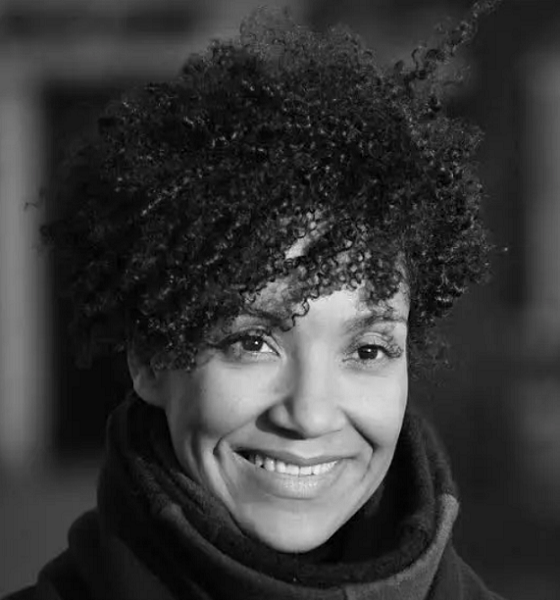

Amanda Coulson, founding director of TERN (a gallery housed in the Bahamas, representing Bahamian and Caribbean artists), Trinidadian artist Christopher Cozier, and Trinidadian Bahamian writer Christian Campbell, recently shared their indignation at the cancellation of the exhibition Van Lévé: Sovereign Visions from the Creole and Maroon Americas and Amazonia. The show, “Van lévé. Visions souveraines des Amériques et de l’Amazonie créoles et marronnes (Guadeloupe, Guyane, Martinique et Haïti),” was slated to run from October 31, 2026, to April 5, 2027, at Centre Pompidou-Metz.
As they remind us, “it would have been the first collective exhibition in France about art from and of the French and Franco-Creole Caribbean.” They have circulated a letter in support of the curator, Claire Tancons (shown above), and to the fifty-plus artists, whose work had been included. Below, I include an excerpt from their call to action, with links to the petition, followed by a copy of the letter. [Also see our previous post Artists decry Centre Pompidou’s cancellation of Caribbean art exhibition.] Campbell, Coulson, and Cozier explain:
“We have responded to Van Lévé’s traditional call-and-response structure and now invite you to respond in turn by reading and signing this open letter: A Caribbean Response in Support of Van Lévé. In so doing, we will be providing the kind of global response that we trust could weigh in favorably for the restoration of this exhibition in France, or at another institution elsewhere, and with it, the aspiration of a people with the innumerable faces of the Tout Monde. You can sign the letter here. Please share with your network.”
A Caribbean Response in Support of Van Lévé
Here we go again. The exhibition Van Lévé: Sovereign Visions of the Creole and Maroon Americas and Amazonia, conceived by Guadeloupean curator Claire Tancons, was scheduled to open at the Centre Pompidou-Metz on October 31, 2026. The disturbing news of the cancellation of this Caribbean exhibition, featuring contemporary art from Guadeloupe, Guyane, Martinique and Haiti, due to “budgetary constraints” urges us to confront crucial though unaddressed problems of the relationship between aesthetics and politics in the art world.
Several months ago, Tancons raised concerns that space contractually assigned to Van Lévé had been, without notice, reassigned to a marble sculpture by Italian artist Maurizio Cattelan—a thirty-six foot hand with the middle finger raised. Tancons was right to raise concerns for more reasons than physical space. In her new book After Caliban: Caribbean Art in a Global Imaginary, Bahamian art historian Erica Moiah James carefully examines Cattelan’s “6th Caribbean Biennial,” which took place in St. Kitt’s in 1999: “Produced by Cattelan and curator Jens Homann, the 6th Caribbean Biennial drew heavily on the presumptions and orchestrations of colonial power that shaped Western modernism, tourism, and the museum. Devoid of substantive artistic exhibition, it was instead an “artist exhibition”; the event consisted solely of celebrated artists who had been invited to take a vacation from art. After the event, Cattelan declared that he was able to fool the art world into believing the biennial was real because the Caribbean “did not exist.”” Cattelan’s declaration of Caribbean non-being merely rehearses the rhetoric of centuries of imperial travel writing (see, for instance, James Anthony Froude). The overlap of these two shows—a collective exhibition of over fifty French Caribbean artists, the first in a major French public institution, and the solo work of a celebrated Italian artist– would amount to a European artist flipping the bird at Caribbean art.
What is the pedagogy of curating Caribbean art if the Caribbean does not exist? French Caribbean art is at once undeniable and disposable in French institutions. In North America and Europe, there has been a tendency to curate Caribbean art by recycling the same recognizable names under the rubric of a generic idea of the region. In academia, the art world and even mainstream newspapers in the US and France, they will cite Édouard Glissant and his theory of the “right to opacity” till the cows come home, but somehow the historical and cultural context of his theories– Amerindian genocide, African slavery and European colonialism– vanishes. It is ironic though unsurprising then, that the Centre Pompidou has frequently engaged with Glissant’s work, even employing his theory of “Tout-Monde” as an organizing principle of the recent survey show, Paris Noir. Whose monde do they mean, we must ask in this year of the centenary of Frantz Fanon, if the art world can attempt to turn Glissantian theory into something like a tourist’s dreadlock wig?
How did we get here? What jail is this? Is deracination the price of the ticket? We must attend to the ways that the art world frames the Caribbean through an imperial logic of extraction– they want Caribbean ideas without the Caribbean in the same way that they want the Caribbean without Caribbean people. Van Lévé refuses this logic of extraction not simply by assembling prominent French Caribbean artists but by rigorously contextualizing their work through substantial research, art historical depth and political commitment. This work is, above all, the practice of ethical attunement.
We must take Van Lévé’s provocative subtitle, “Sovereign Visions,” seriously given the method of grounding the work of these French Caribbean artists, in all their aesthetic complexity, in French Caribbean history and thought. “Sovereign Visions” suggests both the imaginative possibility and futurity of Caribbean aesthetics on the Caribbean’s own terms, and slyly alludes to George Lamming’s notion of the sovereignty of the imagination. It is the right to see and speak for ourselves.
The title Van Lévé (“the wind is rising”) is drawn from a Creole song, “which evolved from a Martinican biguine bèlè to a militant Guadeloupean gwoka and, ultimately, to a Caribbean anthem calling for unity or uprising.” In a 2015 performance of Van Lévé in Paris by Guadeloupean group Akiyo, the lead singer Jean-Pierre Coquerel opens up his rich vibrato a capella, then, as if to summon spirit, crouches and looks away as he presents the mic to the crowd, his gold chains blinging. The people sing back to him in ecstatic unison, hands in the air. He points one finger to the sky and begins a roll call: Guadeloupe! Martinique! Haiti! Guyane! This call and response, this possibility of collectivity, animates Van Lévé; the call and response within the French Caribbean and Amazonia, and between the French Caribbean and France, between the French Caribbean and the wider Caribbean, between the French Caribbean and the African Diaspora, between the French Caribbean and the world.
As this breakthrough exhibition calls out, Van Lévé!, who will respond?
— Christian Campbell
First responders:
Christian Campbell
Amanda Coulson
Christopher Cozier
Amanda Coulson, founding director of TERN (a gallery housed in the Bahamas, representing Bahamian and Caribbean artists), Trinidadian artist Christopher Cozier, and Trinidadian Bahamian writer Christian Campbell, recently shared their indignation at the cancellation of the exhibition Van Lévé: Sovereign Visions from the Creole and Maroon Americas and Amazonia. The show, “Van lévé. Visions souveraines des Amériques et






